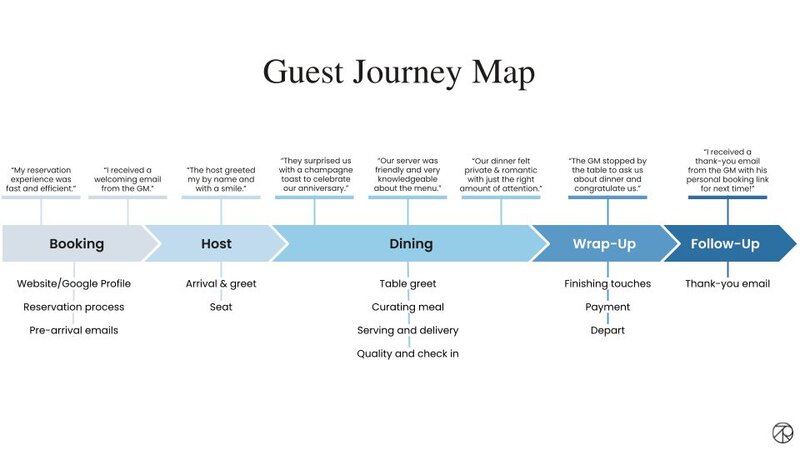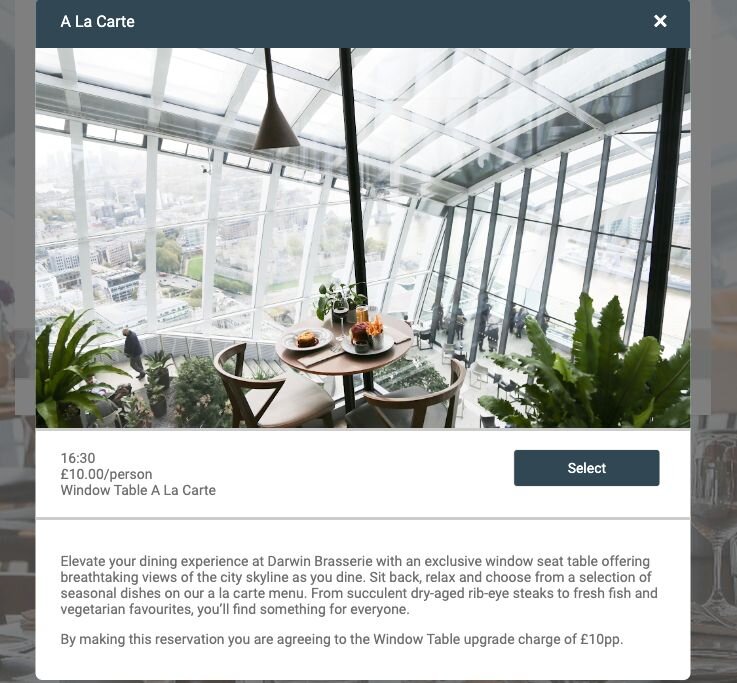How to Fix Inconsistency with a Restaurant Customer Journey Map (Free Template)
5 min read
Jul 28, 2025

5 min read
Jul 28, 2025

If you're running a restaurant today, you've probably felt it: that gap between what you expect your team to deliver and what actually happens on the floor. Not because they don’t care, but because something’s missing, a north star for how service should feel to the guest.
The SOPs are in place. The training is done. But when the pressure’s on, consistency slips and customer loyalty with it.
This isn’t a staffing issue or a skill gap. It’s a strategy gap.
According to our 2025 Industry Report, 31% of U.S. operators say they struggle to deliver a consistent guest experience. And 28% admit they don’t know who to personalize service for, or how. If you can’t clearly define what an excellent dining experience looks and feels like from the guest’s point of view, your team can’t consistently deliver it.
To help close that gap, we turned to someone who’s been helping restaurant owners solve this problem for decades: Fred LeFranc, founding partner of restaurant consultancy Results Thru Strategy.
With more than 40 years in hospitality, including roles as CEO, COO and President at brands like Flat Rock Grille, Ruby’s Diner and Louise’s Trattoria, Fred’s work sits at the intersection of strategic planning, operations, branding and human behavior.
In this article, Fred shares his framework for mapping the guest journey — a tool to help operators move beyond service mechanics and design experiences with intention. You’ll learn how to apply it in your restaurant to boost consistency and guest loyalty.
You’ll also get a free guest journey map template to bring the strategy to life with your team.
Most restaurants have service training nailed down. Greet the guest. Offer a special. Clear the plates. Smile. The mechanical part is there, but what’s often missing is the emotional context behind the job.
“I’ve looked at hundreds of training programs,” Fred says. “They’re all about the task, not the guest. There’s nothing in them about how the guest feels.”
That disconnect is what leads to uneven service. Two servers following the same checklist can deliver wildly different customer experiences because one made the guest feel seen, while the other just went through the motions.
And that difference matters. 74% of diners say they’ve returned to a restaurant after a unique, personalized experience. In a competitive market, “memorable” isn’t a nice-to-have, it’s your growth strategy.
Mapping the guest journey fills the gap that training leaves behind. It makes emotion the anchor of the experience and helps every team member see the guest through the same lens.
The restaurant customer journey is the full experience a guest has with your brand, from the first online search or reservation to the moment they leave your venue and the follow-up that brings them back.
Customer journey mapping isn’t just a spreadsheet exercise. It’s a storytelling tool that reorients your entire team around what the guest is actually experiencing across each stage of service.

Fred’s framework starts with a deceptively simple but powerful approach: write a first-person narrative from the guest’s perspective.
Walk through the experience as they would, from booking and arrival to paying the check and heading out the door. What are they thinking? How do they want to feel?
To help you break this down, Fred recommends five key steps.
Not all guests are looking for the same thing. Some want to celebrate a birthday. Others want a quick lunch. Some want to be surprised. Others want comfort. And if your team doesn’t know who’s in front of them, it’s hard to meet those customer expectations, let alone exceed them.
Start by identifying your key guest personas based on the real people who show up every week.
Fred’s advice? Start with three.
Start by asking your team: Who do we see the most? What are they usually here for? Your hosts, servers and floor managers often have the clearest sense of recurring customer behavior and pain points.
Then layer in what the data tells you. If you’re using a restaurant CRM like SevenRooms, look for booking behaviors, tags, special occasions and order history.

Who always celebrates a birthday? Who dines at the bar solo every Thursday? Who orders premium menu items? Who returns after a well-timed thank-you email?
Once you match team intuition with CRM insights, the patterns become clear and so do the personas:
“If you're a family restaurant, you see kids. If you're a hip cocktail bar, you know it’s dates and singles,” Fred says. “Just define it.”
Once your team knows who they’re serving, it becomes far easier to map each of your customer journeys with intention and consistency.
Next, walk through every point of contact a guest has with your brand, from the moment they find you to the moment they leave (and beyond). Don’t stop at what happens inside the four walls — this starts online.
A great example of improving the guest journey comes from Darwin Brasserie, located at the top of London’s Sky Garden. The team noticed that many guests were dining to celebrate special occasions, and often requested window seats, which were available on a first-come, first-served basis. However, limited availability often led to guest disappointment and friction during the booking process.
So, through SevenRooms, they added a paid window seat upgrade to the reservation process. This created a smoother guest experience, gave diners more control and added a new source of revenue for the restaurant.

When you take the time to understand who your guests are, why they come to your restaurant and how they move through each interaction, you can uncover small but impactful ways to optimize the journey and improve customer retention.
This is where the strategy becomes human.
Write a first-person story from the guest’s perspective, walking through their experience as they would describe it. What should they see, hear, feel? What matters to them at each step?
Then write a matching narrative from the employee’s point of view. What are they doing to create that outcome? What’s their role in shaping the moment?
“When a team reads the guest narrative, something clicks. They’re not just serving ‘Table 42’ anymore. They’re part of someone’s celebration or escape from a bad day. That’s when hospitality becomes real,” says Fred.
This storytelling tool is the backbone of an effective customer journey map and a powerful way to keep teams aligned, even during busy shifts or with first-time hires.
What should the guest feel at each point in their journey? Welcomed? Celebrated? Relaxed?
Fred encourages narrowing this to one or two emotional outcomes per stage. It gives staff a clear north star without scripting their behavior.
Then bring in the senses. What’s the lighting like? The tone of voice at the table? The music in the background? The aroma when they sit down? These ambiance details shape how a guest feels about the space, and whether they’ll return.
Your menu items also reinforce the emotional goal. Consider how you might spotlight seasonal dishes or signature cocktails that help underscore the occasion.
Measurement keeps the guest journey map from becoming a “nice idea” that doesn’t stick. But the goal isn’t to drown in data, it’s to track what actually reflects emotional success.
Operational KPIs are still important: seat-to-greet time, ticket pacing, table turns and wait times.
But emotional impact is what drives loyalty, and you need signals that capture it. This is where guest feedback becomes critical.
With tools like SevenRooms’ automated customer feedback surveys, you can capture insights in real time, directly from the source. Guests will tell you what worked, what didn’t and how the experience made them feel, often within hours of their visit.

Pair that with other emotional indicators like:
Fred swears by credit card tip percentage. “When you’ve got servers consistently earning 20–25%, that’s not just good mechanics, that’s meaningful connection. That’s how you know they’re resonating with guests,” Fred says. “It’s not about upselling, it’s emotional impact.”
At one restaurant group Fred worked with, his team printed 11x17 customer journey maps and handed them to every employee. Not just management but every host, every server, every busser. They walked through it together. This is who your guest is. This is what they’re here for. This is how you make them feel.
The change was immediate.
“We found that if you can have employees read that story, they develop more empathy for the guest. They realize, oh, yeah, there's a human being experiencing what I am doing,” Fred shared.
Loyalty doesn’t come from hitting service times. It comes from creating a feeling guests want to return to and delivering it consistently.
“There’s one goal,” Fred told us. “To create the desire to return. Not just the intent — the desire.”
Guest journey mapping gives your team the clarity to create those moments on purpose. It turns ordinary service into memorable experiences.
Want to bring this to life in your own restaurant? Download the free guest journey map template and example to get started.
Or, if you’re looking for expert support, connect with Fred and his team at Results Thru Strategy. They’ve helped hundreds of restaurant businesses design experiences that drive real loyalty and revenue.
“I think service is an act of love. And if you talk to employees about it in that context, it changes their relationship with their guests. It can improve social media scores, traffic count, the whole nine yards.”
Download our free customer journey map to create your own!